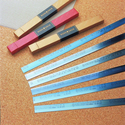The ‘invisible’ industry
17 March 2011Nathan Glass, Managing Director of EMG DieCutting, follows the development of the diecutting industry, and opens up the debate on steel quality for converters.
When I first came into this industry, diecutting was a foreign entity, an almost invisible industry to the general public. If you think about it, we cannot go an hour of our normal day without using something that has been diecut, but if you ask a person to explain what diecutting is, then the blank expression appears and you find out why it is an invisible industry. People recognise that their morning cereal comes out of a cardboard box, but the steps it takes to create this box never enter their thoughts. The art and skill of die making is only one of the steps needed, and if you go back one more step there is an art in making all the components that go into a die.
The history of diecutting stretches back to the mid-1800’s. Although not recognised in the industrial revolution as a milestone, I believe it was, and we can use a simple example of shoe making to show what a massive impact it has had on our world today. Shoes were made to measure, skilfully cut for the individual foot, meaning no two shoes were exactly the same. You can imagine the time it took and why shoes were so expensive. The first development for diecutting came in what was called a Mallet Handle Die. This allowed the shoe maker to standardise the sizes of shoes and open up mass production. Again, in the mid-1800s, a printer in England was setting up his printing press to crease some paper stock. He applied too much pressure to the creasing rule in the press and the creasing rule cut through the paper. By mistake, his actions opened up the idea of using steel rule to cut paper and then the company Notting started to produce steel rule cutting blades.
Since Notting, there have been a number of quality improvements needed to keep up with developments in die making. The steel used for converting is a good example and really the focus for this article. The criteria needed by die makers is so that only the best quality steel manufacturers can service this special combination of hardened steel, to give as many cuts as needed, and flexibility of the steel, to make intricate shapes and designs.
Steel for converting
Having the capabilities to manufacture decarburised steel with a fine micro structure is what is needed, and even when you approach some of the largest steel manufacturers in the world, it would take them years to achieve the consistency and accuracy that is demanded by the converting industry. Hung Shuh is a manufacturer of steel for the die making industry. It has its own in-house Ebner heat treatment system and can produce rules with up to 0.08mm decarburised area. This is a benchmark for the industry and what should be offered as standard by all steel suppliers.
This really is one industry where low cost, low quality steel is just not acceptable. The steel needs to react to the skill of the die maker consistently, getting exactly the same bends every time make for an efficient operation. The steel should be hard but flexible so that it does not crack under pressure.
Other key qualifiers when looking for a steel supplier are:
¦ Thickness tolerance
¦ Height tolerance
¦ Flexibility
¦ Flatness
¦ Hardness
The introduction of automatic bending machines for the die makers has highlighted that steel quality is paramount. Inconsistencies in the thickness of the steel can cause material to jam in the machines; and inconsistencies in the height of the steel can cause major time delays in setting up for the converter. Now put a cost against these problems and compare that with the price you paid for the cheaper steel.
I am sure this is not new to you, but ideally what I hope for is that it opens up discussions from the converter to the die maker to the diecutting supplier. Finding the best product to use depends on many questions and there are so many products in the market that we can help each other.
Having worked with Sandvik for many years, and now working with Hung Shuh, I have grown to appreciate what diecutting has brought to the world. Although it may be invisible to the majority of people, at least we in the industry can respect the technical steps required to achieve the perfect end product.
Nathan Glass, MD of EMG DieCutting. Nathan Glass The quality of steel rules used in diecutting is paramount. EMG External weblinksConverting Today is not responsible for the content of external internet sites.EMG



